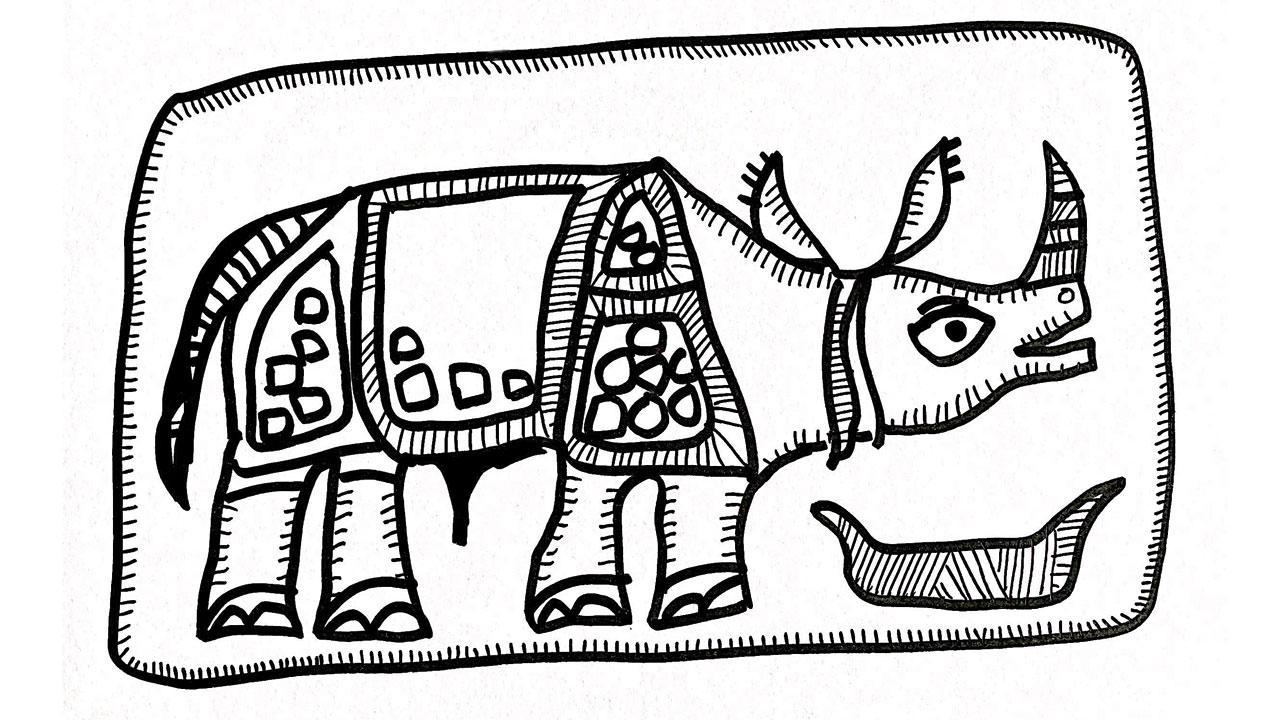While the rhinoceros is a real animal seen in nature, one is not sure if the Harappan unicorn was real or fantastic

Illustration/Devdutt Pattanaik
 We know the one-horned rhino is the state animal of Assam. As per a folk poetry in the Terai region, Vishwakarma created this beast by mixing elephant skin, horse hooves, crocodile eyes, bear brain, lion heart and a bull’s horn.
We know the one-horned rhino is the state animal of Assam. As per a folk poetry in the Terai region, Vishwakarma created this beast by mixing elephant skin, horse hooves, crocodile eyes, bear brain, lion heart and a bull’s horn.
ADVERTISEMENT
In the Harappan civilisation, which thrived 4,500 years ago, along the northwest banks of the Indus River, we find seals that show the rhinoceros. This indicates that the rhinoceros lived even in the western part of India in ancient times, when the ecology was very different. We also find the mysterious one-horned bovine or cow-like unicorn (unlike the equine or horse-like unicorn of Western mythology) on Harappan seals. While the rhinoceros is a real animal seen in nature, one is not sure if the Harappan unicorn was real or fantastic.
The rhino is referred to as a thick-skinned Khadga in the Rig Veda. Arjun’s bow Gandiva is linked to the Gandaka, another word for rhinoceros in Sanskrit. Clearly, the rhinoceros with its thick hide and sharp horn was venerated by warrior Aryans. The thick hide of the rhinoceros has been used by warriors for their shields and is considered an impregnable weapon. In the Gita, there is a verse where we find Krishna referring himself to Ekashringa or the one-horned creature. This leads people to often wonder whether the Varaha avatar was actually a rhinoceros and not a wild boar.
The rhinoceros is part of Jain mythology as the symbol of the Jain Tirthankar Shreyansnath. He is the eleventh Tirthankar. Khaggavisana Sutta of the Buddhists uses the solitary horn of the rhinoceros as a metaphor of the solitary life of a monk.
Wander alone like a rhinoceros! Free from longing, finding no pleasure in the world’s games, love, or sensual bliss, abstaining from adornment, speaking the truth, wander alone like a rhinoceros! Abandoning offspring, spouse, father, mother, riches, grain, relatives, & sensual pleasures altogether, wander alone like a rhinoceros! Shattering fetters, like a fish in the water tearing a net, like a fire not coming back to what’s burnt, wander alone like a rhinoceros! Eyes downcast, not footloose, senses guarded, with protected mind, not oozing, or burning, with lust, wander alone like a rhinoceros!
Also read: South Asia record films at Toronto International Film Festival
In Gujarat, there is a folk deity known as the Dhavdi Mata, who rides a rhinoceros. Dhavdi Mata is from the Gujarat region and the Harappan seals are from the same area. This suggests that the rhinoceros was a very important part of western part of India in ancient times, and these are memories from that period. Dhavdi Mata is worshipped even in parts of Pakistan and was sacred to local nomadic communities.
The rhinoceros also appears in a folk version of the Mahabharata. Here, we are told that the Pandavas hunted a celestial rhinoceros, whose flesh had to be offered as part of a ceremony to enable their dead father, Pandu, enter heaven. In folk Ramayan, Ram hunts the golden deer for the same reason. The idea of offering meat to dead kings was clearly a common practice in India before puritanism took over and all funeral offerings became rice or barley or grain.
This rhinoceros hunted by Pandavas, in the Garhwali version of the Pandav Leela, was found in Indraloka. While in Sarla Das’s Odia Mahabharata, the rhinoceros was found in Shiva’s garden. Arjun hunted this animal, but had to confront the animal’s caretaker, who turned out to be his own son by a Naga princess. This boy’s name was Nagarjuna, a character much revered in folklore.
The author writes and lectures on the relevance of mythology in modern times. Reach him at devdutt.pattanaik@mid-day.com
 Subscribe today by clicking the link and stay updated with the latest news!" Click here!
Subscribe today by clicking the link and stay updated with the latest news!" Click here!







